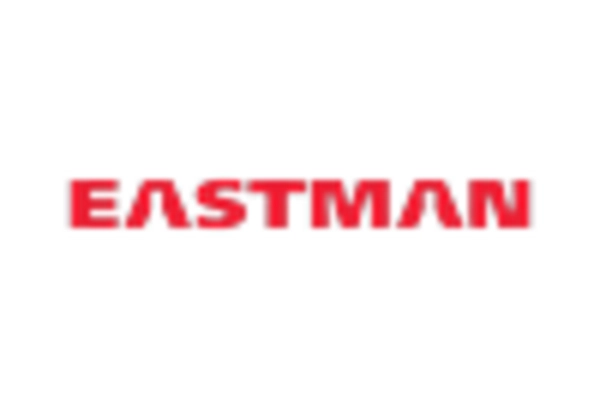Rising Demand in Solvent Applications
The Octyl Alcohol Market experiences a notable increase in demand due to its extensive use as a solvent in various industrial applications. This alcohol is particularly valued for its ability to dissolve a wide range of substances, making it essential in the formulation of paints, coatings, and adhesives. As industries continue to prioritize high-performance solvents, the market for octyl alcohol is projected to grow. Recent data indicates that the solvent segment accounts for a significant share of the overall octyl alcohol consumption, reflecting a trend towards more efficient and effective formulations. The increasing need for environmentally friendly solvents further propels the demand for octyl alcohol, as it is often perceived as a safer alternative compared to traditional solvents. Thus, the rising demand in solvent applications is a critical driver for the Octyl Alcohol Market.
Regulatory Support for Sustainable Chemicals
The Octyl Alcohol Market is positively impacted by regulatory support aimed at promoting sustainable chemicals. Governments and regulatory bodies are increasingly implementing policies that encourage the use of environmentally friendly substances in industrial applications. This regulatory landscape fosters a favorable environment for the adoption of octyl alcohol, which is often viewed as a safer alternative to more hazardous chemicals. The push for sustainability is evident in various sectors, including automotive, construction, and consumer goods, where octyl alcohol is utilized as a key ingredient. Market data indicates that compliance with stringent environmental regulations is driving manufacturers to seek out sustainable options, thereby enhancing the demand for octyl alcohol. As such, regulatory support for sustainable chemicals plays a crucial role in shaping the dynamics of the Octyl Alcohol Market.
Growth in the Cosmetic and Personal Care Sector
The Octyl Alcohol Market is significantly influenced by the expansion of the cosmetic and personal care sector. Octyl alcohol is widely utilized in the formulation of various personal care products, including lotions, creams, and hair care items, due to its emollient properties. The increasing consumer preference for high-quality personal care products has led to a surge in demand for octyl alcohol, as manufacturers seek to enhance product performance and sensory attributes. Market data suggests that the personal care segment is one of the fastest-growing applications for octyl alcohol, with a projected compound annual growth rate that outpaces other sectors. This growth is further supported by the rising trend of natural and organic products, where octyl alcohol serves as a versatile ingredient. Consequently, the growth in the cosmetic and personal care sector serves as a vital driver for the Octyl Alcohol Market.
Technological Innovations in Production Processes
Technological advancements in the production processes of octyl alcohol are reshaping the Octyl Alcohol Market. Innovations such as improved catalytic processes and more efficient separation techniques have led to higher yields and reduced production costs. These advancements not only enhance the economic viability of octyl alcohol production but also contribute to sustainability efforts by minimizing waste and energy consumption. As manufacturers adopt these new technologies, the market is likely to witness an increase in supply, which could stabilize prices and make octyl alcohol more accessible to various industries. Furthermore, the integration of automation and digital technologies in production facilities is expected to streamline operations, thereby improving overall efficiency. Thus, technological innovations in production processes emerge as a significant driver for the Octyl Alcohol Market.
Increasing Applications in the Automotive Industry
The Octyl Alcohol Market is witnessing a surge in applications within the automotive sector. Octyl alcohol is increasingly being used in the formulation of automotive coatings, adhesives, and sealants, owing to its excellent solvent properties and compatibility with various materials. The automotive industry is undergoing a transformation, with a growing emphasis on lightweight materials and high-performance coatings that enhance durability and aesthetics. Recent market data suggests that the automotive segment is becoming a key driver of octyl alcohol consumption, as manufacturers strive to meet the evolving demands of consumers for more efficient and sustainable vehicles. This trend is likely to continue, as the automotive industry increasingly adopts advanced materials and technologies. Therefore, the increasing applications in the automotive industry represent a significant driver for the Octyl Alcohol Market.


















Leave a Comment